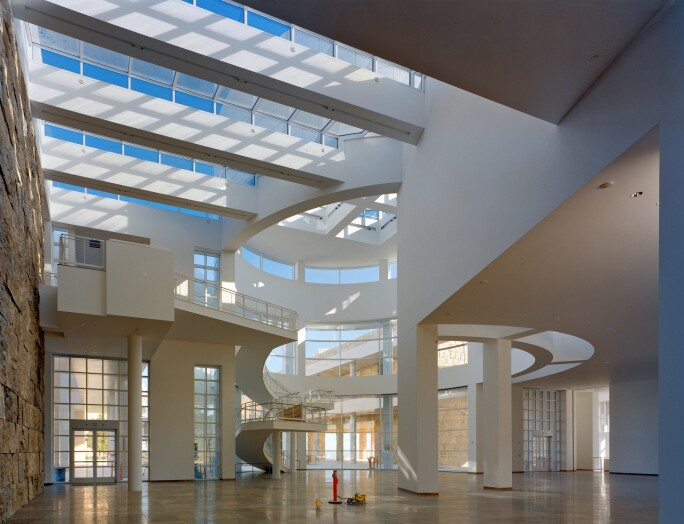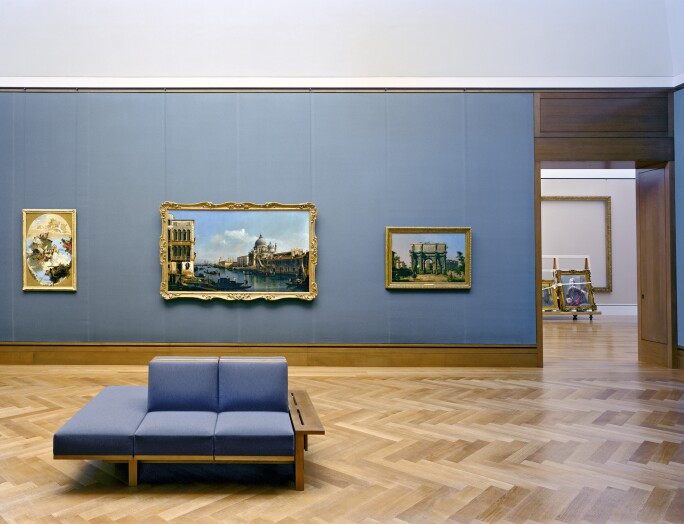Los Angeles - Perched high on a hill overlooking the Pacific Ocean, the Getty Center has welcomed more than 20 million visitors to its Los Angeles campus since it opened two decades ago. Celebrating this milestone anniversary, a new exhibition of photographs by Robert Polidori shows its plush galleries in the final stages of installation before the Center’s opening in 1997.
The Getty Center is home to four separate institutions, all supported by the J. Paul Getty Trust: the J. Paul Getty Museum, the Getty Research Institute, the Getty Conservation Institute and the Getty Foundation. We spoke to James Cuno, the president and chief executive of the J. Paul Getty Trust, about the past and future of the Getty.

Photo by Robert Polidori. James Cuno, president and chief executive of the J. Paul Getty Trust © 2011 J. Paul Getty Trust
Sotheby’s Museum Network: How has the mission of the Getty Center changed since it opened twenty years ago?
James Cuno: I’m proud to say not at all. The founding president, Harold Williams, was hired in 1983 and over the next 14 years he built the Getty, both in content and as a campus for the four programmes based there. He set the agenda and the mission and we’ve followed it ever since. If there are two things that are at the core of the Getty, one is research and one is international engagement.
SMN: What are the innovations that you’re proudest of from the first six years of your tenure?
JC: Two things. The first is the strengthening of the collaborative culture of the Getty campus; the four programmes working together. Collectively there isn’t an institution like the Getty in the world.
The second thing is our commitment to international engagement. We are working on every continent, it seems. We are broadening the perspective of art historical and museum work around the world, and the understanding of the importance of conservation science.
SMN: When people think of the Getty, what do you think they think of?
JC: It’s easy to say that the museum is the most prominent of the four programmes, but people think of the Getty in terms of their contact with it. Conservation scientists anywhere in the world will think of the Getty Conservation Institute, or perhaps the Getty Foundation which often works with it. If you’re an art historian, you’ll think of the Getty Research Institute.
SMN: Is that confusion a problem or a healthy thing?
JC: I think it’s enormously healthy. At first I thought of it as a problem, and spent a great deal of time emphasising the fact that these four programmes collaborate together. Then I realised that people are going to engage with the Getty according to their own work and interests.

Entrance Hall, J. Paul Getty Museum (1997) Courtesy of the artist in conjunction with The Lapis Press © Robert Polidori.
SMN: How important is Los Angeles to the Getty?
JC: It’s our home base. And it was one of the homes of our founder, J. Paul Getty – he built his first museum here [The Getty Villa], although he never saw it finished. The Getty Trust was conceived by its trustees to be advantageous to the then-nascent art-historical culture of Southern California. Most recently, this has been emphasised by the Getty’s ambitious, collaborative Pacific Standard Time venture.
SMN: Richard Meier’s design of the Getty Center emphasises permanence. How do you imagine the Getty Center in two decades’ time?
JC: It was built to symbolise endurance. It’s a destination, so the experience one has coming here is not only of the galleries but of the gardens, and the views over Los Angeles and out across the ocean.
But it’s also going to take some rethinking. Most of this won’t be seen by the visitor, but digital technology is changing the way people work. The offices were designed to be more formal than they might be in the future. The Research Institute has a massive library, but is now considerably online. So the library collection could be taken off site, perhaps, and books retrieved when necessary.
Perhaps not in the next 10 or 20 years, but at some point, there’s also going to be growth of the Getty Center. Despite its expansive site, it is not easy to imagine construction here. But there will be growth somewhere in the world. Growth in collections, activities and staff. All the things that institutions experience as they get older.

Robert Polidori. Venetian Painting 1700-1750 Gallery, J. Paul Getty Museum (1997)
Courtesy of the artist in conjunction with The Lapis Press. © Robert Polidori
Robert Polidori: 20 Photographs of the Getty Museum, 1997 is on at the Getty Center, Los Angeles
12 December 2017 – 6 May 2018